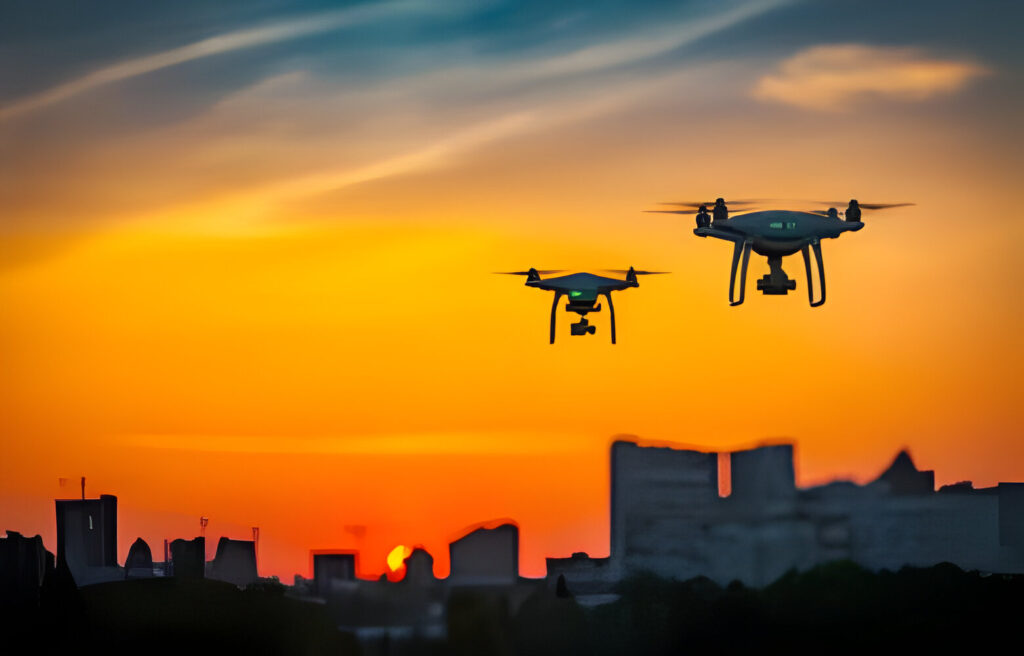In recent years, secrets of surveillance drones have become indispensable tools for law enforcement, military operations, and even civilian applications. Their ability to operate efficiently in various environments, including nighttime, has significantly enhanced their utility. In this comprehensive guide, we delve into the intricacies of surveillance drones, focusing mainly on their appearance and capabilities during nighttime operations.
Understanding Surveillance Drones at Night
Exploring the Nocturnal Realm: secrets of surveillance drones’ Night Vision Capabilities

Secrets of surveillance drones are equipped with advanced night vision technology, allowing them to capture clear images and videos even in low-light conditions. These drones utilize infrared sensors and thermal imaging cameras to detect heat signatures and movement in the dark. This enables them to conduct covert operations and gather critical intelligence under the cover of darkness.
Sleek Designs for Stealthy Operations
The design of secrets of surveillance drones plays a crucial role in their nocturnal effectiveness. These drones often feature sleek, aerodynamic bodies that minimize noise and maximize maneuverability. Additionally, they are equipped with minimalistic lighting to maintain a low profile during nighttime surveillance missions.
Illuminate the Night: LED Lights and Tactical Lighting

Despite their emphasis on stealth, many secrets of surveillance drones are equipped with LED lights and tactical lighting systems. These lights serve multiple purposes, including enhancing visibility for operators and signaling during emergencies. However, they can be toggled on and off based on operational requirements to maintain covert operations.
Silent Guardians: Noise Reduction and Acoustic Dampening
One of the critical challenges in nocturnal surveillance is minimizing noise to avoid detection. Secrets of surveillance drones are equipped with noise-reduction technologies and acoustic-dampening materials to operate silently during nighttime missions. This ensures that they can approach targets discreetly without alerting potential threats.
Camouflage and Concealment: Adaptation to Nighttime Environments
Surveillance drones are often designed with camouflage patterns or matte finishes to blend seamlessly into nighttime environments. This enhances their stealth capabilities and reduces the risk of visual detection, allowing them to operate covertly in various terrains and lighting conditions.
Empowering Operators: Intuitive Controls and Nighttime Interfaces
To facilitate nighttime operations, secrets of surveillance drones are equipped with intuitive controls and user-friendly interfaces. Operators can access night vision modes, adjust lighting settings, and monitor critical parameters with ease, enabling efficient decision-making during nocturnal missions.
Beyond Human Vision: Sensor Fusion and Augmented Reality
Advanced surveillance drones leverage sensor fusion and augmented reality technologies to provide operators with comprehensive situational awareness during nighttime operations. By integrating data from multiple sensors and overlaying augmented reality graphics, these drones enhance operators’ perception of their surroundings, enabling them to navigate and engage targets effectively in the dark.
Adaptive Flight Dynamics: Stability and Maneuverability in Low-Light Conditions
Navigating through complex environments in low-light conditions requires superior stability and maneuverability. Secrets of surveillance drones are equipped with adaptive flight dynamics systems that optimize their performance in nighttime scenarios. These systems adjust flight parameters in real time to ensure smooth and precise movements, even in challenging lighting conditions.
Surviving the Elements: Weatherproof Construction and Durability
Surveillance drones are built to withstand harsh environmental conditions, including those encountered during nighttime operations. They feature weatherproof construction and durable materials that protect critical components from moisture, dust, and extreme temperatures. This ensures reliable performance and longevity, even in adverse weather conditions.
Challenges and Innovations: Overcoming Obstacles in Nocturnal Surveillance

While surveillance drones offer significant advantages in nighttime operations, they also face particular challenges. These include limited visibility, potential signal interference, and the risk of detection by hostile forces. However, ongoing innovations in sensor technology, artificial intelligence, and stealth capabilities are addressing these challenges and expanding the capabilities of secrets of surveillance drones in nocturnal environments.
Ethical Considerations: Balancing Security and Privacy
As surveillance drones become more prevalent in nocturnal operations, it is essential to consider the ethical implications of their use. Balancing security needs with privacy concerns is a delicate task, requiring clear policies and regulations governing drone operations. By ensuring transparency, accountability, and respect for individual rights, we can harness the potential of surveillance drones while safeguarding civil liberties.
The Future of Nocturnal Surveillance: Innovations and Opportunities
The future of surveillance drones looks promising, with ongoing advancements in technology and operational capabilities. From enhanced autonomous features to seamless integration with other surveillance systems, drones will continue to play a vital role in nocturnal surveillance operations. By embracing innovation and collaboration, we can unlock new possibilities and ensure a safer, more secure future.
Surveillance Drones: What Do Drones Look Like at Night?
Surveillance drones exhibit a fascinating array of features and capabilities that make them ideally suited for nocturnal operations. From stealthy designs to advanced sensor technologies, these drones are designed to thrive in low-light conditions, providing operators with unparalleled situational awareness and intelligence-gathering capabilities.
FAQs (Frequently Asked Questions)
- How do surveillance drones navigate at night?
- Surveillance drones utilize a combination of GPS navigation, onboard sensors, and advanced flight control systems to navigate in low-light conditions. These systems enable precise positioning and autonomous flight capabilities, ensuring safe and efficient operations even in the dark.
- Are surveillance drones equipped with weapons for nighttime operations?
- While some military drones may be equipped with weapon systems, most surveillance drones are designed for reconnaissance and intelligence-gathering purposes only. Their primary function is to collect data and provide situational awareness to operators rather than engage in offensive operations.
- Can surveillance drones be detected at night?
- Surveillance drones are designed to minimize their detectability, but they may still be vulnerable to detection by radar systems or other surveillance technologies. Countermeasures such as low-observable designs and electronic warfare techniques can mitigate the risk of detection, but no system is entirely immune to detection.
- What are the legal implications of using surveillance drones at night?
- The use of surveillance drones, particularly at night, raises various legal and regulatory considerations. Operators must comply with relevant laws and regulations governing drone operations, including privacy laws, airspace regulations, and restrictions on surveillance activities. Failure to adhere to these regulations could result in legal consequences and civil penalties.
- How do surveillance drones capture images and videos at night?
- Surveillance drones are equipped with specialized cameras and imaging systems optimized for low-light conditions. These may include infrared sensors, thermal imaging cameras, and low-light cameras capable of capturing high-resolution images and videos in the dark.
- What measures are taken to protect privacy during nighttime surveillance operations?
- To protect privacy during nighttime surveillance operations, operators must adhere to strict protocols and guidelines governing data collection and use. This may include obtaining consent from affected parties, anonymizing sensitive information, and restricting the use of surveillance data for legitimate purposes


